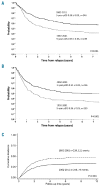Relapsed childhood acute lymphoblastic leukemia in the Nordic countries: prognostic factors, treatment and outcome
- PMID: 26494838
- PMCID: PMC4697893
- DOI: 10.3324/haematol.2015.131680
Relapsed childhood acute lymphoblastic leukemia in the Nordic countries: prognostic factors, treatment and outcome
Abstract
Relapse is the main reason for treatment failure in childhood acute lymphoblastic leukemia. Despite improvements in the up-front therapy, survival after relapse is still relatively poor, especially for high-risk relapses. The aims of this study were to assess outcomes following acute lymphoblastic leukemia relapse after common initial Nordic Society of Paediatric Haematology and Oncology protocol treatment; to validate currently used risk stratifications, and identify additional prognostic factors for overall survival. Altogether, 516 of 2735 patients (18.9%) relapsed between 1992 and 2011 and were included in the study. There were no statistically significant differences in outcome between the up-front protocols or between the relapse protocols used, but an improvement over time was observed. The 5-year overall survival for patients relapsing in the period 2002-2011 was 57.5±3.4%, but 44.7±3.2% (P<0.001) if relapse occurred in the period 1992-2001. Factors independently predicting mortality after relapse included short duration of first remission, bone marrow involvement, age ten years or over, unfavorable cytogenetics, and Down syndrome. T-cell immunophenotype was not an independent prognostic factor unless in combination with hyperleukocytosis at diagnosis. The outcome for early combined pre-B relapses was unexpectedly poor (5-year overall survival 38.0±10.6%), which supports the notion that these patients need further risk adjustment. Although survival outcomes have improved over time, the development of novel approaches is urgently needed to increase survival in relapsed childhood acute lymphoblastic leukemia.
Copyright© Ferrata Storti Foundation.
Figures
References
-
- Schmiegelow K, Forestier E, Hellebostad M, et al. Long-term results of NOPHO ALL-92 and ALL-2000 studies of childhood acute lymphoblastic leukemia. Leukemia. 2010;24(2):345–354. - PubMed
-
- Stary J, Zimmermann M, Campbell M, et al. Intensive Chemotherapy for Childhood Acute Lymphoblastic Leukemia: Results of the Randomized Intercontinental Trial ALL IC-BFM 2002. J Clin Oncol. 2014; 32(3):174–184. - PubMed
-
- Schroeder H, Garwicz S, Kristinsson J, Siimes MA, Wesenberg F, Gustafsson G. Outcome after first relapse in children with acute lymphoblastic leukemia: a population-based study of 315 patients from the Nordic Society of Pediatric Hematology and Oncology (NOPHO). Med Pediatr Oncol. 1995;25(5):372–378. - PubMed
-
- Moricke A, Zimmermann M, Reiter A, et al. Long-term results of five consecutive trials in childhood acute lymphoblastic leukemia performed by the ALL-BFM study group from 1981 to 2000. Leukemia. 2010;24(2):265–284. - PubMed
Publication types
MeSH terms
LinkOut - more resources
Full Text Sources
Other Literature Sources


